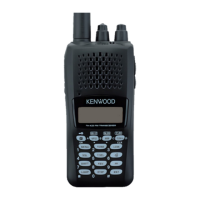TH-K20A/K20E
19
ADJUSTMENT
Frequency and Signaling
The transceiver has been adjusted for the frequencies
shown in the following table. When required, re-adjust them
following the adjustment procedure to obtain the frequencies
you want in actual operation.
■
Test Frequency
CH Receive (MHz) Transmit (MHz)
1 159.05000 159.10000
2 144.05000 144.10000
3 173.95000 173.90000
4 159.00000 159.00000
5 159.20000 159.20000
6 159.40000 159.40000
7~16 - -
■
Signaling
No. RX (Decode) TX (Encode)
1 None None
2 None 100Hz Square Wave
3 CTCSS 67.0Hz CTCSS 67.0Hz
4 CTCSS 151.4Hz CTCSS 151.4Hz
5 CTCSS 210.7Hz CTCSS 210.7Hz
6 CTCSS 254.1Hz CTCSS 254.1Hz
7 DCS D023N DCS D023N
8 DCS D754I DCS D754I
9 None
DTMF
(Code: 159D)
10 None
DTMF
(Code: D)
11 None 1633Hz Tone
Preparations for Tuning the Transceiver
Before attempting to tune the transceiver, connect the
unit to a suitable power supply.
Whenever the transmitter is tuned, the unit must be con-
nected to a suitable dummy load (i.e. power meter).
The speaker output connector must be terminated with a
8
dummy load and connected to an AC voltmeter and an
audio distortion meter or a SINAD measurement meter at all
times during tuning.
■
Tuning frequency
Tuning point Receive (MHz) Transmit (MHz)
Low 136.05000 136.10000
Center 146.05000 146.10000
Center*1 155.05000 155.10000
High 173.95000 173.90000
*1: This center frequency is used for adjustment of DCS Balance
and Maximum Deviation.
Adjustment Points
TX-RX UNIT
Component side view
Foil side view
Note: When replacing CF200 and C
D
200, apply bond to
the point shown in the fi gure.
CN300
CV
SPG
SPK
MIC300
+B
GND
ANT
BATT+
BATT-
CD200
S417
CF200
S418
PTT
MONI
VR300
S419
J301
J300
MIC
SP
POW/VOL
ENCODER
BATT+ (7.5V)
BATT– (GND)
–
+

